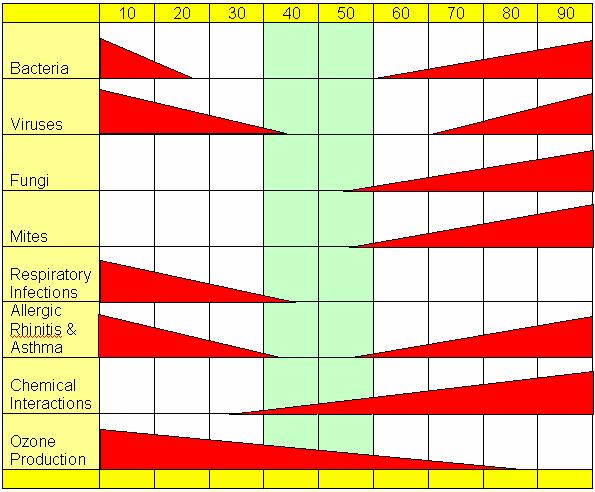Humidification
Overview – Why Humidify?
Air that is too dry is just as much of a problem as air that is too wet, and in many cases, much more dangerous to people and interior furnishings.
Low humidity can be a serious health risk to people with certain kinds of ailments. Certain kinds of bacteria and viruses are more easily spread in dry conditions; not to mention the pain of dry, itchy skin and the pain of broken chapped lips! Low humidity can cause wood to shrink and splinter, wall paper to come loose, and static electricity to ruin sensitive electronic equipment.
NOTICE: Care must be taken to properly clean any humidification system; a dirty humidifier can be the cause of more health problems than solutions.
Numerous studies done by ASHRAE and other indoor air quality experts, suggest an optimum Rh range of 40 to 60%. Dryer or wetter causes different kinds of problems, at each extreme. See the chart below, based on ASHRAE sponsored research.

Humidification Equipment
 There are several ways to add moisture to air. The two main categories are those that add thermal energy to vaporize the water and those that simply spray water through misting nozzles or some sort of evaporation pad and count on natural vaporization to do the rest. Another kind of non-thermal humidifier is the ultrasonic method that uses something like sound waves at an ultrasonic frequency to produce very fine water droplets that resembles fog without the addition of heat. The best method will depend on how much water needs to be vaporized how quickly, and what equipment may already be available to help distribute the moisture.
There are several ways to add moisture to air. The two main categories are those that add thermal energy to vaporize the water and those that simply spray water through misting nozzles or some sort of evaporation pad and count on natural vaporization to do the rest. Another kind of non-thermal humidifier is the ultrasonic method that uses something like sound waves at an ultrasonic frequency to produce very fine water droplets that resembles fog without the addition of heat. The best method will depend on how much water needs to be vaporized how quickly, and what equipment may already be available to help distribute the moisture.
Residential equipment is likely to be either a central furnace mounted unit or a stand-alone cabinet unit located in a central area of the house. Neither of these units use extra input thermal energy to vaporize the water; rather they flow water in a way that allows it to have a lot of contact with dry, moving air so that it readily evaporates.
 Water quality is a major issue with humidification equipment. Small units suggest the use of only distilled water; this is much too expensive to be practical for most season-long humidification needs. A humidifier should be easy to clean and/or provide replaceable elements. A dirty humidifier is a known contributor to all kinds of nasty organisms that lead to air quality and health problems.
Water quality is a major issue with humidification equipment. Small units suggest the use of only distilled water; this is much too expensive to be practical for most season-long humidification needs. A humidifier should be easy to clean and/or provide replaceable elements. A dirty humidifier is a known contributor to all kinds of nasty organisms that lead to air quality and health problems.
Furnace mounted humidifiers need to be kept in good working condition. If they are allowed to leak, they can ruin the furnace from rust and other water related problems.
Central humidifiers should be controlled with an accurate humidistat so that only the needed amount of humidity is added. Too much moisture can lead to other problems such as condensation and mold growth. A good setting is 35 – 45% RH.
More Information
See http://www.howstuffworks.com/humidifier.htm
See http://houseandhome.msn.com/improve/HOHIntro.aspx?s=Humidifers
Manufacturers
Too many to list.
For some good information on forced air furnace mounted units, see:
The Carrier web site at www.residential.carrier.com
Source: Text Bob Fegan 12/2008; chart Bob Fegan based on ASHRAE Data and similar charts by ASHRAE, ACCA and others; humidifier graphic from http://houseandhome.msn.com/improve/HOHIntro.aspx?s=Humidifers 10/2003;
© 2008 Energy Solutions Center400 N. Capitol Street NWWashington, DC 20001 All rights reserved. Legal Contact our webmaster
